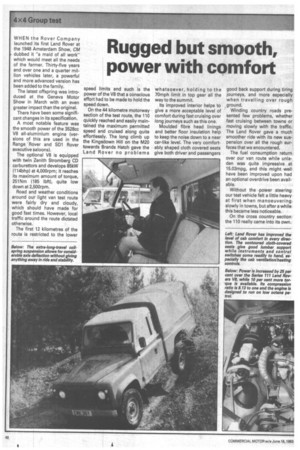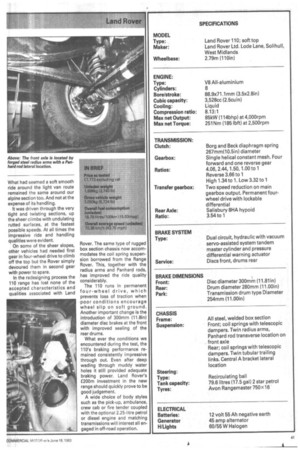Rugged but smooth, power with comfort
Page 42

Page 43

If you've noticed an error in this article please click here to report it so we can fix it.
WHEN the Rover Company launched its first Land Rover at the 1948 Amsterdam Show, CM dubbed it "a maid of all work" which would meet all the needs of the farmer. Thirty-five years and over one and a quarter million vehicles later, a powerful and more advanced version has been added to the family.
The latest offspring was introduced at the Geneva Motor Show in March with an even greater impact than the original.
There have been some significant changes in its specification.
A most notable feature was the smooth power of the 3528cc V8 all-aluminium engine (versions of this are used in the Range Rover and SD1 Rover executive saloons).
The optional V8 is equipped with twin Zenith Stromberg CD carburettors and develops 85kW (114bhp) at 4,000rpm; it reaches its maximum amount of torque, 251Nm (185 lbft), quite low down at 2,500rpm.
Road and weather conditions around our light van test route were fairly dry and cloudy, which should have made for good fast times. However, local traffic around the route dictated otherwise.
The first 12 kilometres of the route is restricted to the lower speed limits and such is the power of the V8 that a conscious effort had to be made to hold the speed down.
On the 44 kilometre motorway section of the test route, the 110 quickly reached and easily maintained the maximum permitted speed and cruised along quite effortlessly. The long climb up the Kingsdown Hill on the M20 towards Brands Hatch gave the Land Rover no problems
whatsoever, holding to the 70mph limit in top gear all the way to the summit.
Its improved interior helps to give a more acceptable level of comfort during fast cruising over long journeys such as this one.
Moulded fibre head linings and better floor insulation help to keep the noise down to a near car-like level. The very comfortably shaped cloth covered seats give both driver and passengers good back support during tiring journeys, and more especially when travelling over rough ground.
Winding country roads presented few problems, whether fast cruising between towns or moving slowly with the traffic. The Land Rover gave a much smoother ride with its new suspension over all the rough surfaces that we encountered.
The fuel consumption return over our van route while unladen was quite impressive at 15.03mpg, and this might well have been improved upon had an optional overdrive been available.
Without the power steering our test vehicle felt a little heavy at first when manoeuvering slowly in towns, but after a while this became less noticeable.
On the cross country section the 110 really came into its own. What had seemed a soft smooth ride around the light van route remained the same around our alpine section too. And not at the expense of its handling.
It was driven through the very tight and twisting sections, up the sheer climbs with undulating rutted surfaces, at the fastest possible speeds. At all times the impressive ride and handling qualities were evident.
On some of the sheer slopes, other vehicles had needed first gear in four-wheel drive to climb off the top but the Rover simply devoured them in second gear with power to spare.
In the redesigning process the 110 range has lost none of the accepted characteristics and qualities associated with Land Rover. The same type of rugged box section chassis now accommodates the coil spring suspension borrowed from the Range Rover. This, together with the radius arms and Panhard rods, has improved the ride quality considerably.
The 110 runs in permanent four-wheel drive, which prevents loss of traction when poor conditions encourage wheel slip on soft ground. Another important change is the introduction of 300mm (11.8in) diameter disc brakes at the front with improved sealing of the rear drums.
What ever the conditions we encountered during the test, the 110's braking performance remained consistently impressive through out. Even after deep wading through muddy water holes it still provided adequate braking power. Land Rover's £200m investment in the new range should quickly prove to be good judgement.
A wide choice of body styles such as the pick-up, ambulance, crew cab or fire tender coupled with the optional 2.25-litre petrol or diesel engine and matching transmissions will interest all engaged in off-road operation.








































































































